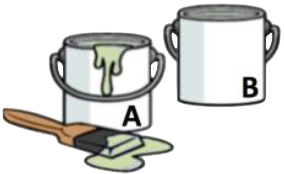These are challenging times with school closures focusing attention on how to provide equitable emotional, physical, and educational support for students from a distance. To help with the question of educational support in mathematics, we are providing resources and we conducted short online workshops in the hope they help you provide mathematical learning opportunities for your students who are English learners (ELs)*. This information is drawn from our work with grades 6–8 mathematics teachers and English learner specialists as part of the Visual Access to Mathematics (VAM) project at Education Development Center (EDC).
We believe that the same underlying principles and strategies from regular classroom instruction should be taken into consideration when navigating a remote learning situation. Specifically, when engaging students in mathematics, it remains critical to ensure that all students are having access to active problem solving and mathematical communication in line with the Standards for Mathematical Practice. Classroom strategies that support student access to the language of challenging tasks, or that support students to share their thinking, can be adapted for remote learning.
Click a gray button to show or hide resources for a topic.
Strategies for supporting ELs
Below are strategies for integrating support for students’ language access and their language production. You may already use these strategies in regular classroom instruction, and here we offer tips about how to consider their use with mathematics tasks you offer to students through remote instruction. The "Example mathematics tasks" section of this web page shows examples of how these strategies can be embedded in tasks for remote learning. Additional information about these strategies is in this language strategy overviews document.
-
Sentence Starters: Sentence starters begin a sentence that students then complete. Provide sentence starters to students to go with the specific tasks that you ask them to work on. Students write responses that complete the sentences. Students can also use sentence starters while talking about their approaches, including while practicing their explanation out loud to themselves, while talking to a parent/guardian or sibling, while talking to others during a video meeting, or while making a recording of their work. You could have students post their responses to a question using a sentence starter in a Google doc, allowing students to see different versions of how the sentence can be completed.
Additional information about using sentence starters during mathematics instruction is available online (try searching for "sentence starter" mathematics), including this document: Supporting Mathematics Discourse with Sentence Starters & Sentence Frames. Some example sentence starters are below:
- My diagram shows the amount of apples as...
- First, I...
- I checked my answer by...
- I noticed that...
- The number of miles she walked in 3 hours is shown on the graph where...
-
3 Reads: Consider adding a “3 reads” space with word problems. An example template for this is provided in the example tasks section, and an approach that includes sentence starters is shown below. For the 3 Reads, students need to read the mathematics task three times, trying to focus on different things each time. They focus on the task context/story, then on what they need to find out, and then on what important information is provided in the task. Students can complete this individually to productively slow down and scaffold their process of making sense of a task, or you could use a process, such as a class Google doc, where students can fill in their answers to the 3 reads so that students can learn from each other and you can moderate their answers and rephrase as needed.
3 Reads 1st Read – Context
The problem is about...
2nd Read – Purpose
I need to find out...
3rd Read – Information
Important information is:
-
Co-constructed Word Banks: Consider making a co-constructed word bank to help students understand the words and/or phrases in a specific task about which they are uncertain. You can insert one or two important words or phrases to start the word bank, and as seems helpful throughout the process. Have students enter words or phrases they think are confusing or important. Other students, or you, can add definitions, examples, and/or pictures to support access and understanding of these words or phrases. Of course, modify your expectations based on your class culture and your knowledge of your students. For example, in some contexts it might be helpful for all students to identify at least one word or phrase. You could collect and assemble the information yourself and send it to students, or you could use online collaboration tools, such as a Google doc, to co-create the word bank (either synchronously or asychronously).
-
Videos and Images: Acting out a word problem task can help students make sense of what the task is about. Consider finding videos online or creating a short video that shows something about the task context. You can also insert images directly into a task that help clarify the task context (for example, a picture of a bucket of paint for a task about paint). Below are two examples with images that may help students understand the problem contexts:
Example mathematics tasks
Below are example mathematics tasks and GeoGebra apps that incorporate structural visual representations such as tape diagrams and double number lines, which can support all students and can be particularly supportive for students who are ELs. The mathematics task examples also incorporate other strategies that may particularly benefit students who are ELs, while also supporting other students to access the task and explain their approaches and solutions.
-
Apps: Below are sets of apps that we developed in GeoGebra as part of our work with mathematics teachers and EL specialists over the past several years. They are free and work on most devices, including mobile devices and Chromebooks. Additional apps are available under the "EDC in Maine" user and by others on the GeoGebra resources page.
-
Mixing Paint Collection: 4 apps and related resources with multiple diagrams and images related to mixing paints in different ratios

-
Percent Change Collection: 3 apps and related resources, including video tutorials, for understanding percent change problems using double number lines

-
-
Mathematics Task Examples with Embedded Strategies: Below are links to examples of mathematics tasks that include strategies that can support students who are ELs. The resources including PDF and editable Google Doc versions, so they can be more easily incorporated in Google Classroom or adapted for your own processes. We hope these examples highlight some of the ways that support for problem-solving, language access, and language production can be integrated into mathematics tasks for remote learning.
We chose Google tools because many of our project educators use Google Classroom and most educators can access and edit them, but these strategies and examples could also be used with a variety of online tools and remote learning scenarios, including packet pick-up and drop-off processes. This choice is not an endorsement of Google or its parent company.
Resource or topic 2 versions of the task PDF Google Doc 1. Sharing Candies

A multi-step word problem about sharing a bag of [individually-wrapped] candies.
Strategies: 3 Reads, sentence starters, image of candies, use of diagrams; appropriate for use with co-constructed word bank
Sharing Candies
PDF Google Doc Example answers for the task above
Related resources

- Pedro's String (a similar task)
- Pedro's String GeoGebra apps:
- Pedro's String (1) creates a tape diagram step-by-step (Spanish version of Pedro's String (1) app)
- Pedro's String (2) requires the user to divide up a tape diagram step-by-step and gives feedback (Spanish version of Pedro's String (2) app)
- Example answers for Pedro's String (above)
2. Mixing Paint

Tasks and apps related to mixing paints in different ratios.
Strategies: 3 Reads, images, acting out with realia video, diagrams; appropriate for use with co-constructed word bank; appropriate for use with interactive visual representations (see apps)
Mixing Sea Green Paint
PDF Google Doc Mixing Sky Blue Paint
PDF Google Doc Example Google Form versions
- Below are examples of Google Form (survey) versions of the mixing paint tasks:
- Create your own versions of the Google Forms:
- Copy the Mixing Sea Green Paint Form or copy the Mixing Sky Blue Paint Form to your Google Drive
- If you see a message to restore a folder, choose to restore.
- Edit your copy of the Form
Example answers for the tasks above
Related resources
- Video shows mixing 3 parts yellow to 4 parts blue
- Google Jamboard for Mixing Sea Green Paint (interactive whiteboard with the partial diagram added; Google help page for Jamboard)
- Additional resources in the Mixing Paint Collection of apps (including the additional example tasks for comparing 2 mixtures, also listed below)
- Example tasks for the Comparing Mixtures Apps
- Example answers for the Comparing Mixtures App tasks (above)
3. Percent Change

Tasks and apps related to understanding on percent change contexts using double number lines.
Strategies: images and interactive visual representations; 3 Reads; appropriate for use with co-constructed word bank
Basketball Markup
PDF Google Doc Computer Sale
PDF Google Doc Example answers for the tasks above
Related resources
- Resources in the Percent Change Collection of apps, including video tutorials, reference information, and more example problems (including the additional example tasks listed below)
- Additional example percent change tasks
- Example answers for the additional percent change tasks (above)
Prior educator webinar opportunities
We offered free 45-minute webinar-style online workshops in April and May, 2020, focused on supporting students who are ELs in mathematics. The workshops focused on supporting language access and language production in mathematics through the use of online resources and tools, including for remote learning and teaching. Although designed primarily for grades 6–8 educators of mathematics and therefore using task examples that address middle grades content, the strategies are widely applicable and all educators were welcome to attend.
If you have a question or comment about the online workshops please email your name, state, district, role, and question/comment to vam@edc.org.
- April 22, 2020: Supporting Student Language Production using Desmos Card Sorts
Explore and discuss ways Desmos cards sorts can support your students who are English learners as you engage in an example card sort with multiple types of representations. Learn how to find and edit card sorts created by others and how to create your own card sort. April 22, 2020, from 3:00 p.m. ET to 3:45 p.m. ET.
- April 29, 2020: Integrating Strategies for Language Access and Production in Mathematics with Percent Change Tasks
Learn and discuss strategies to support language access and language production for students who are English learners during mathematical problem solving with a focus on how to use these strategies when learning and teaching remotely. The workshop will focus on the use of the 3 Reads strategy, co-constructed word banks, sentence starters, and interactive online apps with visual representations within the context of percent change tasks. April 29, 2020, from 3:00 p.m. ET to 3:45 p.m. ET.
- May 6, 2020: Collaborative Online Tools for Pair and Small-Group Work with Visual Representations
Engage with multiple online tools that can be used to support mathematical communication by students who are English learners during remote mathematics learning and teaching, including an online sticky board, polling tool, and shared online documents. Review and discuss different collaboration tools within the context of the Sharing Candies task, as well as how to integrate these tools with language access strategies such as the 3 Reads strategy and acting out with realia. May 6, 2020, from 3:00 p.m. ET to 3:45 p.m. ET.
- May 13, 2020: Integrating Strategies for Language Access and Production with Mathematics Ratio and Proportion Tasks
Experience and discuss a variety of language access and language production strategies that can support students who are English learners during remote mathematics learning. The session will focus on mixing paint problems and a combination of strategies and apps, including Google Jamboards (collaborative online whiteboards) and mixing paint apps created in GeoGebra. May 13, 2020, from 3:00 p.m. ET to 3:45 p.m. ET.
*Note: We use the term English Learners in these resources because that is how students are classified by their schools or districts, although we prefer “students who are multilingual” because it highlights the strengths and resources of students.
Click here for additional resources for the COVID-19 crisis from EDC |

|
Contact the VAM team at vam@edc.org. © 2022 Education Development Center, Inc. All rights reserved. |
The Visual Access to Mathematics: Professional Development for Teachers of English Learners project is supported by the National Science Foundation under Grant No. DRL-1503057. During 2016–2019 the comprehensive program was available without a fee to participants through funding from the National Science Foundation. Any opinions, findings, and conclusions or recommendations expressed are those of the author and do not necessarily reflect the views of the National Science Foundation.

